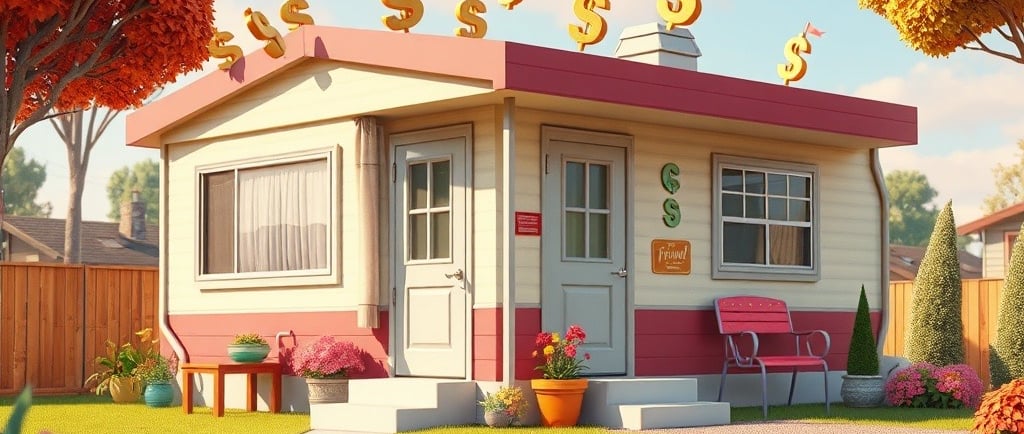The Smart Investment: Why a Prefab Home is a Great Choice
10/1/20257 min read


Understanding Prefab Homes
Prefab homes, short for prefabricated homes, are residential structures that are built off-site in a controlled environment, then transported and assembled at the final location. This method significantly differs from traditional home building, which typically involves constructing a home directly on-site. The key advantages of prefabricated homes include faster construction timelines, cost efficiency, and reduced material waste, making them an increasingly attractive option for homebuyers.
There are several types of prefab homes, namely modular, panelized, and manufactured homes, each differing in their construction methods and characteristics. Modular homes consist of multiple pre-constructed sections or "modules" that are assembled on-site. These sections are built to a high standard and are often indistinguishable from traditional houses once assembled. Panelized homes, on the other hand, use large pre-constructed panels that are delivered to the site and then erected to form the structure. This type allows for a degree of customization while retaining the efficiency of prefabrication.
Manufactured homes, often referred to as mobile homes, are constructed entirely in a factory and then transported to their final location. They are built according to federal codes and are typically less expensive than modular or panelized alternatives. Recent advancements in technology, materials, and design have contributed to a significant increase in the popularity of prefab homes. Consumers are increasingly drawn to the customizable nature and modern aesthetics that these homes offer.
The growing acceptance of prefab homes in the real estate market reflects a shift in attitudes towards sustainable and efficient building practices. As homeowners seek flexibility, affordability, and innovative design, prefabricated homes continue to gain traction as a smart investment choice.
Affordability and Cost-Effectiveness
Investing in a prefab home presents a myriad of financial benefits that make it an attractive option for homebuyers seeking affordability. One of the primary advantages is the significantly lower construction costs associated with prefabricated homes. As these homes are constructed in a factory setting, the streamlined manufacturing process leads to reduced material waste and optimal labor efficiency. Consequently, this translates to decreased overall expenses when compared to traditional home-building methods.
Additionally, labor costs are notably lowered in prefab construction. With the majority of the assembly being completed off-site, there is minimal requirement for numerous skilled workers on the actual building site. This efficient use of labor not only accelerates the construction timeline but also allows builders to pass these savings along to the homeowners, resulting in more competitive pricing in the market.
Quick installation timelines further enhance the cost-effectiveness of prefab homes. The ability to construct modules in a controlled environment allows for faster assembly on-site, reducing the time and expenses generally associated with weather delays or construction setbacks. Homebuyers can thus move into their new residence sooner, which can result in additional savings by minimizing temporary housing costs.
Moreover, prefab homes often come equipped with energy-efficient features designed to reduce utility bills over time. Many models incorporate advanced insulation, energy-efficient windows, and modern appliances that contribute to lower energy consumption. The savings generated through reduced energy use and lower maintenance costs can accumulate, further enhancing the financial viability of choosing a prefab home. By considering these advantages, prospective homeowners can see that a prefab home presents an economically sensible choice that addresses both immediate and long-term financial needs.
Speed of Construction
The construction speed of prefab homes is one of the most compelling advantages that appeals to potential homeowners and investors alike. Unlike traditional home-building methods, which can take several months, prefab homes are constructed in a more efficient manner that significantly shortens the timeline. This efficiency arises from the factory-controlled environment where prefabricated components are produced. By assembling various parts in a climate-controlled facility, builders can minimize delays caused by adverse weather conditions, ensuring a steady flow of production.
In many cases, the actual assembly of a prefab home on-site can be completed in a matter of days. Once the components arrive at the location, skilled teams can quickly and effectively put them together, resulting in remarkably shorter wait times before the homeowner can move in. This speed of construction not only allows for a quicker transition into one’s new living space but also impacts broader financial planning decisions. For instance, saving time on construction can lead to reduced labor costs and minimized interest payments on construction loans.
Moreover, the fast pace of prefab home construction facilitates better alignment with investment timing. Investors looking to maximize returns can establish cash flow sooner due to the reduced waiting period before the property becomes habitable. This can be particularly advantageous in competitive real estate markets, where timing can be critical. As a result, the streamlined processes associated with prefab homes not only streamline construction but also enhance the overall investment strategy. Ultimately, when it comes to speed, the benefits of choosing a prefab home can be significant, making it an appealing option for many aspiring homeowners and savvy investors.
Sustainability and Eco-Friendliness
In recent years, the construction industry has evolved to meet the increasing demand for sustainable and eco-friendly building options. Prefab homes, also known as modular or manufactured homes, offer significant environmental benefits that appeal to environmentally-conscious buyers. One primary aspect of prefab homes is their use of sustainable materials. Many manufacturers prioritize eco-friendly components, such as reclaimed wood, recycled steel, and non-toxic insulation, which can help in minimizing the depletion of natural resources.
Energy efficiency is another critical feature of prefab homes. These dwellings are designed with advanced building techniques that improve insulation and reduce energy consumption. For instance, prefab homes often integrate high-performance windows, efficient heating and cooling systems, and renewable energy sources like solar panels. This ensures that homeowners not only enjoy a comfortable living environment but also save on utility costs. The focus on energy-efficient designs not only contributes to lowering monthly expenses but also decreases the overall carbon footprint of the residence.
Additionally, the construction process of prefab homes is inherently more sustainable than traditional building methods. As these homes are often constructed in a controlled environment, there is less waste generated during the building process. Manufacturers can optimize their material usage and recycle any excess, ensuring that more materials are efficiently utilized and less end up in landfills. With a streamlined construction timeline, the time and resources spent on-site are minimized, promoting further energy savings and reduced environmental impact.
In essence, choosing a prefab home is a responsible investment for individuals seeking to build a sustainable future. Through the utilization of eco-friendly materials, energy-efficient designs, and a reduced construction footprint, prefab homes represent a significant approach to creating a greener and more sustainable living environment.
Customization and Modern Design Options
Prefab homes are increasingly recognized for their remarkable flexibility in design, allowing homeowners to create a living space that truly reflects their personal style and preferences. One of the most appealing aspects of these homes is the wide range of customizable features available to buyers. From floor plans to finishes and layout options, the possibilities are extensive, making prefab houses adaptable to various tastes and lifestyles.
Homebuyers can select from various floor plans, which may include open-concept layouts or more traditional segmented spaces, depending on their needs. This level of customization ensures that each homeowner can choose a layout that aligns with their functional requirements and aesthetic desires. Additionally, many companies offering prefab homes now provide the opportunity to modify existing designs or even create entirely bespoke floor plans tailored to individual specifications.
Finishes play a critical role in the overall appeal of a prefab home. Buyers can choose from a comprehensive selection of materials and color palettes to enhance both the interior and exterior of their dwelling. From siding options to roofing materials and interior fixtures, this level of detail allows homeowners to achieve the perfect look and feel for their space. Furthermore, modern design trends are increasingly influencing prefab homes, making them attractive options for those seeking contemporary aesthetics.
Another significant advantage of prefab homes is the incorporation of innovative designs that prioritize sustainability and energy efficiency. Many manufacturers are now integrating eco-friendly materials and advanced construction techniques, contributing to a smaller carbon footprint. As such, homeowners who opt for prefab can enjoy stylish living environments while also making responsible choices. Overall, the customization and modern design options in prefab homes cater to a diverse array of homeowners, ensuring that there are suitable choices for everyone.
Quality Control and Building Standards
When considering the construction of a home, one of the most significant aspects that homeowners prioritize is the quality of the materials and workmanship involved. Prefabricated homes, often referred to as prefab homes, offer a distinct advantage in this area due to their unique manufacturing processes. These homes are built in controlled environments, where the conditions can be optimized for the best possible construction outcomes. This controlled setting allows for better management of the building materials and ensures that they are not subject to the variances that can occur during traditional on-site construction.
During the manufacturing phase of prefab homes, rigorous quality control processes are implemented. Every component is subjected to thorough inspections throughout the assembly process, ensuring that any defects or issues are identified and rectified before they become larger problems. This meticulous attention to detail results in a final product that is often more durable and higher in quality when compared to conventionally built homes. The use of precision technology and techniques in a factory setting contributes to the overall structural integrity of these buildings.
Furthermore, prefab homes adhere strictly to building codes and standards that govern the construction industry. Regulatory bodies impose these standards to ensure safety, environmental protection, and structural robustness. Manufacturers of prefab homes are required to comply with local and national building codes, which means that these homes undergo a series of evaluations and certifications. This compliance provides buyers with peace of mind, knowing that their investment meets high safety and quality benchmarks. By embracing these quality control measures and adhering to stringent building standards, prefab homes emerge as a reliable and smart investment for prospective homeowners.
Market Trends and Future Growth
The real estate market has undergone significant transformations in recent years, with prefab homes emerging as a standout trend. Prefabricated homes, known for their efficiency and sustainability, have witnessed a surge in demand, reflecting a shift in consumer preferences towards more modern housing solutions. Factors driving this trend include the rising costs of traditional construction, increasing awareness of environmental concerns, and the desire for affordable housing options. As more people seek alternatives to conventional homes, the prefab industry has positioned itself as a viable and competitive option.
One of the notable market trends is the increasing acceptance of prefab homes within both urban and rural environments. Once perceived as a temporary or less desirable living arrangement, contemporary prefab designs have evolved to reflect aesthetic appeal and functionality. The advent of innovative technologies and advanced building materials has further enhanced the appeal of prefab homes, allowing for customization and improved energy efficiencies. This transition in perception has opened up new avenues for potential homeowners who are seeking sustainable living while maintaining design integrity.
The future growth of the prefab home industry looks promising. Market analysts project a steady increase in prefab housing sales as more consumers recognize the long-term benefits. Investors focusing on this sector could see significant appreciation in property values over time. Additionally, as government policies increasingly support sustainable development and address housing shortages, the prefab sector is likely to experience favorable conditions for growth. This environment presents a unique investment opportunity that not only appeals to homeowners but also to investors looking for solid returns in an evolving market.
Overall, the combination of consumer acceptance, innovative advancements, and strategic market conditions suggests that now is an opportune time to consider investments in prefab homes. As the industry continues to expand, those who choose to invest in prefab properties may reap the rewards of this upward trajectory.
